
Over the past decade, SIT has become known for its strong partnerships with local industries and the wider community. With a focus on applied research, experiential learning, and collaborative problem-solving, we actively engage with diverse stakeholders, forming meaningful connections and making a significant impact.
SIT's industry engagement is driven by its mission to bridge the gap between theory and practice, equipping students with practical skills that are highly valued by employers. Through internships, cooperative education, and industry placements, students gain invaluable exposure to various sectors, enabling them to apply their learning in real-world settings. This approach not only enhances employability but also fosters a culture of innovation and entrepreneurship among students.
In addition to industry partnerships, SIT recognises the importance of collaboration within a broader context. We actively seek collaborations with non-profit organisations, community groups, and governmental bodies. Likewise in applying knowledge and skills to address real-world challenges, we aim to promote experiential learning, foster a sense of social responsibility, and make a positive impact on society.
In this section on SIT’s engagement with industry and community, we will look at our programming in the Integrated Work Study Programme (IWSP), Continuing Education and Training (CET), and projects and activities our students undertake during their studies here.
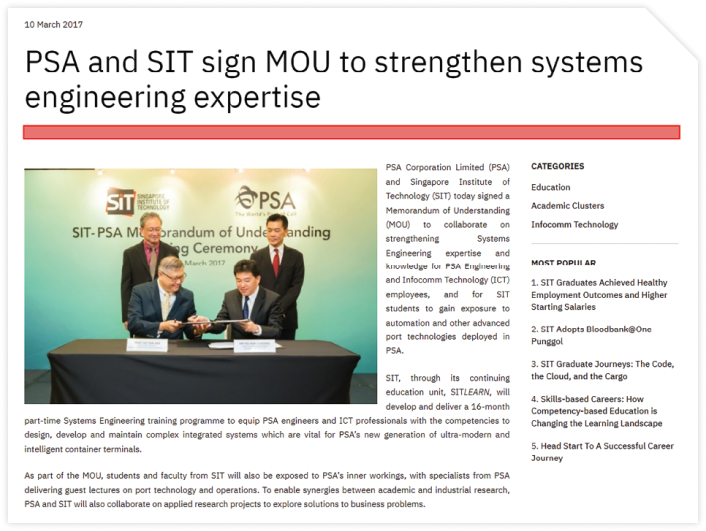
 Over the decade, SIT has signed MOUs with private companies and government agencies that allow our students to be exposed to real-world challenges.
Over the decade, SIT has signed MOUs with private companies and government agencies that allow our students to be exposed to real-world challenges.
Integrated Work Study Programme
— Minister for Education Chan Chun Sing at the Straits Times Education Forum on 10 February 2022
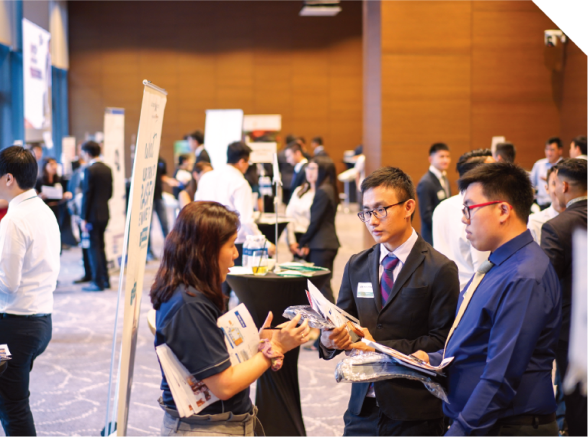
The Integrated Work Study Programme (IWSP) offered by the Singapore Institute of Technology (SIT) is our distinctive feature that involves significant effort by the Academic Clusters and Centre for Career Readiness in connecting industry partners with the curriculum. Students in our conferred and joint degree programmes must undertake eight to 12 months of paid work in the relevant industry to complete their studies.
The primary focus of IWSP is for students to put both their professional and career skills to the test by experiencing the employment process in its entirety, from recruitment to being trained on the job. It allows students to apply the knowledge and skills learned in the classroom to real-life situations and projects, thus bridging the gap between theory and practice.
 ICT and SEEMS IWSP Preview on 29 August 2018
ICT and SEEMS IWSP Preview on 29 August 2018
Integrated Work Study Programme

Unlike a conventional internship, IWSP is credit-bearing and work performance by students is evaluated by work supervisors and mentored by SIT Academic Staff. The employment is designed by SIT and industry participants to align industry needs with maximum industrial immersion for the students.
With the integration of classroom knowledge with real-world application, students are subsequently required to develop their final-year Capstone Projects. A Capstone Project identifies an area in the industry the student had been working in that can be improved, and for which a solution can be developed. This presents the opportunity for both the company and student to continue working closely together after IWSP. The SIT Capstone Project not only helps students demonstrate their competency and readiness for the workforce but also allows them to showcase their abilities to potential employers. It serves as evidence of their practical skills, industry engagement, and project management capabilities.
 IWSP Poster Day for Civil Engineering degree programme 2024 where each
student displayed their Capstone Poster for evaluation by their respective Academic
supervisor.
IWSP Poster Day for Civil Engineering degree programme 2024 where each
student displayed their Capstone Poster for evaluation by their respective Academic
supervisor.
BEng (Hons) Mechatronics Systems, Year 3 Cluster: Engineering

Winardi’s dream of a career in software engineering almost got derailed by his A-level results. SIT helped him to get his dream back on track. A trimester at DigiPen’s Redmond campus followed by an IWSP internship at LionsBot further helped to sharpen his drive and tenacity.
 Winardi with NFL player and coach Jim Zorn while he was on OIP in
Seattle, USA
Winardi with NFL player and coach Jim Zorn while he was on OIP in
Seattle, USA
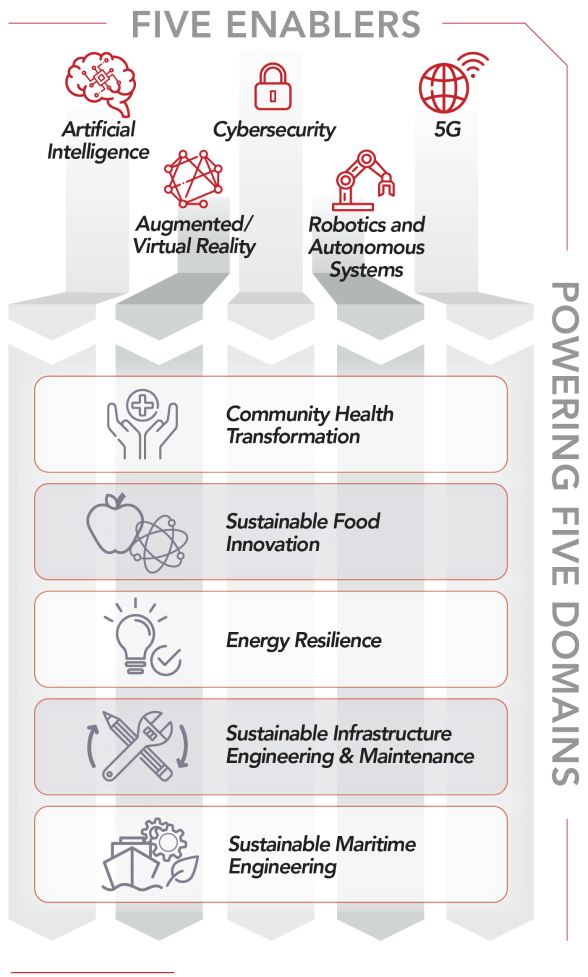
Applied research is a vital aspect of applied learning at SIT as spelled out in our current Mission Statement. It helps not only our academic staff stay current in their fields, but importantly, to better equip SIT students for the future. By incorporating research findings and industry trends into the curricula, students gain valuable hands-on experience and can apply their knowledge to real-world problems.
The integration of applied research bridges the gap between theory and practice, ensuring that graduates possess the skills and competencies needed to succeed in their chosen fields. Additionally, applied research drives innovation and encourages collaboration with industry partners. SIT actively addresses industry challenges, develops innovative solutions, and transfers research findings into practical applications, thereby contributing to the growth of Singapore's industry.
Therefore in SIT, we regard applied research as enhancing student learning, keeping academic staff updated, fostering innovation, and facilitating industry collaboration; all contributing to a well-rounded education and industry-readiness in our SITizens.
 SIT identified five domain areas to develop for applied research
capabilities and has set up Applied Research Centres (ARCs) that involve academic staff
working on complex challenges.
SIT identified five domain areas to develop for applied research
capabilities and has set up Applied Research Centres (ARCs) that involve academic staff
working on complex challenges.
The three-prong approach taken in SIT to advance our applied research programming:
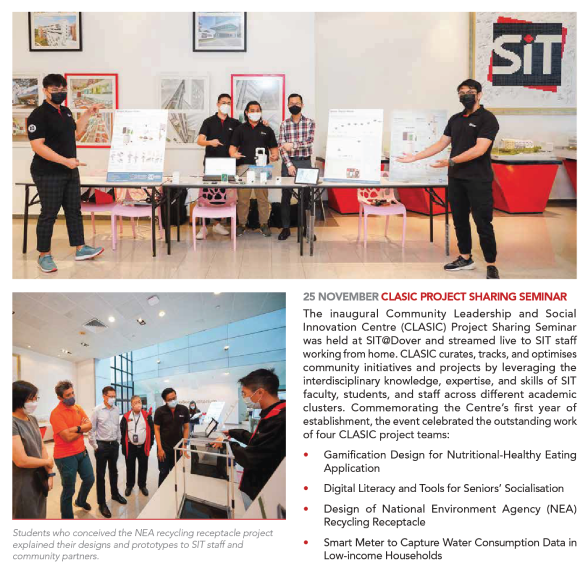
CLASIC was formed in October 2020. It aims to bring together the expertise, knowledge, and skills of SIT students, faculty, and staff from various degree programmes across academic clusters and domains for projects involving service-learning or social innovation.
The guiding principle behind CLASIC's selection of projects and initiatives is to enhance the quality of life for beneficiaries. By engaging in these activities, students and faculty members are able to leverage their current expertise and experience in more meaningful ways. Moreover, their understanding of societal needs is deepened through their involvement in such projects, ultimately informing their professional practice.
CLASIC aspires to become the partner of choice for both the industry and community. Its vision includes helping SIT to be the preferred institution for institutes of higher learning in the realm of community-related projects and initiatives. By collaborating with organisations in the community, CLASIC aims to create a lasting impact on society and foster meaningful relationships within the broader community.
Source: SIT Annual Report 2022, p.17.— Minister for Education Chan Chun Sing at the Straits Times Education Forum on 10 February 2022

— Ms Jane Wong, Dy Principal Engineer (Sustainability Strategy – Public Sector and Household), NEA
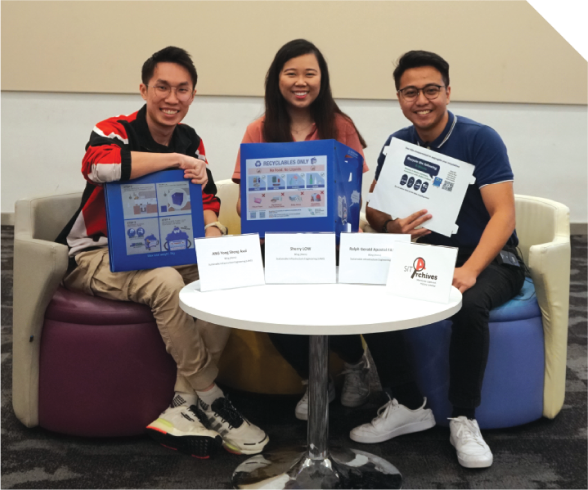
BlooBox, a collaborative effort between NEA and SIT, is a compact, foldable, sturdy, and washable receptacle designed to kickstart recycling habits at home in Singapore. From March 19 to April 30 2023, every household was able to collect the recycling receptacle for free from 140 vending machines island-wide. The first completed project under CLASIC, BlooBox was designed by three students from the SIE (Land) undergraduate programme, guided by the Professional Officers Division (POD). The students, Sherry Low, Ralph Gerald Apostol Faller and Axel Ang were then in Year One when they heard about the project and while they were doing their internship at RaPID, they developed the design proposal for NEA’s consideration. The successful design was inspired by origami to infuse fun into the design so as to make recycling interactive and exciting.
 BlooBox Designers
From left to right:
Axel Ang, Sherry Low, Ralph Gerald Apostol Faller
BlooBox Designers
From left to right:
Axel Ang, Sherry Low, Ralph Gerald Apostol Faller
The Bloobox is crafted from a unique material comprising two different polymers, making it very strong, durable and recyclable. It can hold up to 5kg of recyclables with a divider to keep electronic waste separated. Its foldability is a key feature as the box can be kept flat, making it easy for NEA to distribute it to households and for its storage.
To enhance user experience and knowledge, recycling information and steps are prominently displayed on the outside of the receptacle and its divider. Importantly, it features our logo and a barcode link to the CLASIC webpage that provides information about the project.
Given four weeks to execute the product, Ralph, Sherry and Axel applied their classroom learning in mechanical engineering to the development of their prototypes. While they were able to create different types of folds on paper easily, it was challenging to translate them onto a stiff material where precision was crucial to creating a successful design. It was at the last minute that the team was able to finalise a design with a simple fold that was eventually chosen. Theirs was one of six proposals presented to NEA for consideration.
Design and Prototyping Phase
Prior to designing, the students were guided by CLASIC as they surveyed some 70 households to understand their “pain points around recycling and waste management”. They applied the knowledge gathered in their approach to designing a receptacle that was easy to use, practical and can be placed conveniently in the kitchen.
Kwong Kwok Kwen, Senior PO was the Principal Investigator (PI) for the project. With his expertise in manufacturing technology and project management, he guided the students during the design stage, from patent search to avoid infringing on copyrights to finalising the design and prototyping. He also ensured that the design directions complied with the brief stipulated by NEA.
The team also connected with RaPID and Maker Space who created prototypes from scratch by cutting plastic sheets by hand as well as 3-D printing.
Manufacturing Phase
The next phase was undertaken by
Raymond Keh, Principal PO who sourced for manufacturers who were able to produce the
BlooBox. Through a tedious process of trial and error, he guided and saw through the
whole
process with the manufacturer, ensuring the right choice of raw materials used,
precision in
cutting and folding, and quality control in the production.
Timeline
Jul 2021 – Nov 2021
Nov 2021 – Dec 2022
26 Nov 2022 – 23 Dec 2022
19 Mar 2023 – 30 Apr 2023
SITLearn (SIT Lifelong Education for Adaptability, Relevance and Nimbleness)
— Minister for Education Chan Chun Sing, Straits Times Education Forum, 10 February 2022
An integral component of SIT’s strategy for a symbiotic relationship with industry is SITLearn – SIT’s lifelong learning division. Building on an interdependent and mutually beneficial partnership, SITLearn collaborates with companies and government agencies to deliver an array of courses aligned to our national movement to drive industry-wide transformation and growth under the SkillsFuture initiative. These courses address key challenges and opportunities in each industry. Significantly, in niche areas where SIT is recognised through our degree programmes, the offering of CET courses and Pre-Employment Training further enhances our reputation and standing. Since its establishment in 2016, SITLearn has trained over 14,000 adult learners as part of our CET under open enrolment, customised programmes, professional preparatory courses and examinations, and career transition programmes. We also offer modular certification courses leading to Specialist Certificates, Postgraduate Certificates and Postgraduate Diplomas.
 Listen to the interview with Robin Ngan, Director of SITLearn to know more about CET, the SIT way.
Listen to the interview with Robin Ngan, Director of SITLearn to know more about CET, the SIT way.
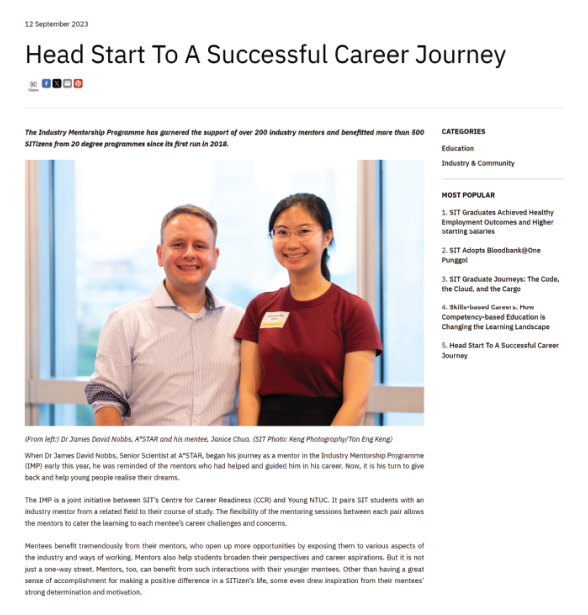
The Industry Mentorship Programme (IMP) is a joint initiative between the Centre for Career Readiness (CCR) and Young NTUC. Introduced in 2018, the programme pairs SIT’s undergraduates with Industry Mentors, so that these students can gain a deeper understanding of the sector they will be working in, to develop their career paths and be prepared for the workplace. The IMP has won the Empower Awards for Best Career Development Programme.
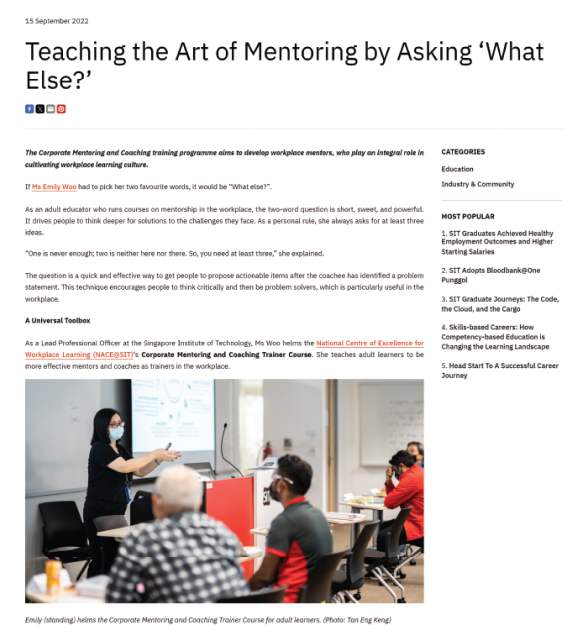
The National Centre of Excellence for Workplace Learning (NACE@SIT) is the first workplace learning centre set up in an Autonomous University. It runs the Corporate Mentoring and Coaching programme, which is designed to develop workplace mentors so that they may foster an environment conducive to learning for SIT’s students participating in the Integrated Work Study Programme within their respective companies.
The Integrated Work Study Programme (IWSP) is a unique feature of SIT-conferred and joint degree programmes. Unlike an internship, the IWSP allows students to integrate classroom knowledge with real-world applications through work placements.
In 2014, SIT signed a momentous MOU with key Accounting industry leaders to support the IWSP for students in the Accountancy programme. Career Services, now Centre for Career Readiness (CCR) arranged an IWSP Preview in 2015 for the students to meet with potential companies to understand the expectations and demands of their placements.
In tandem with the Preview, CS also organised the Career Fair for graduating students to explore job opportunities. As SIT expanded its degree offerings over time, CS decided to bring the Preview and the Career Fair together on a more comprehensive platform. This led to the first Career Nexus in 2016. This annual networking event continues to this day, with Career Nexus 2024 seeing over 2000 students meeting with around 250 companies.
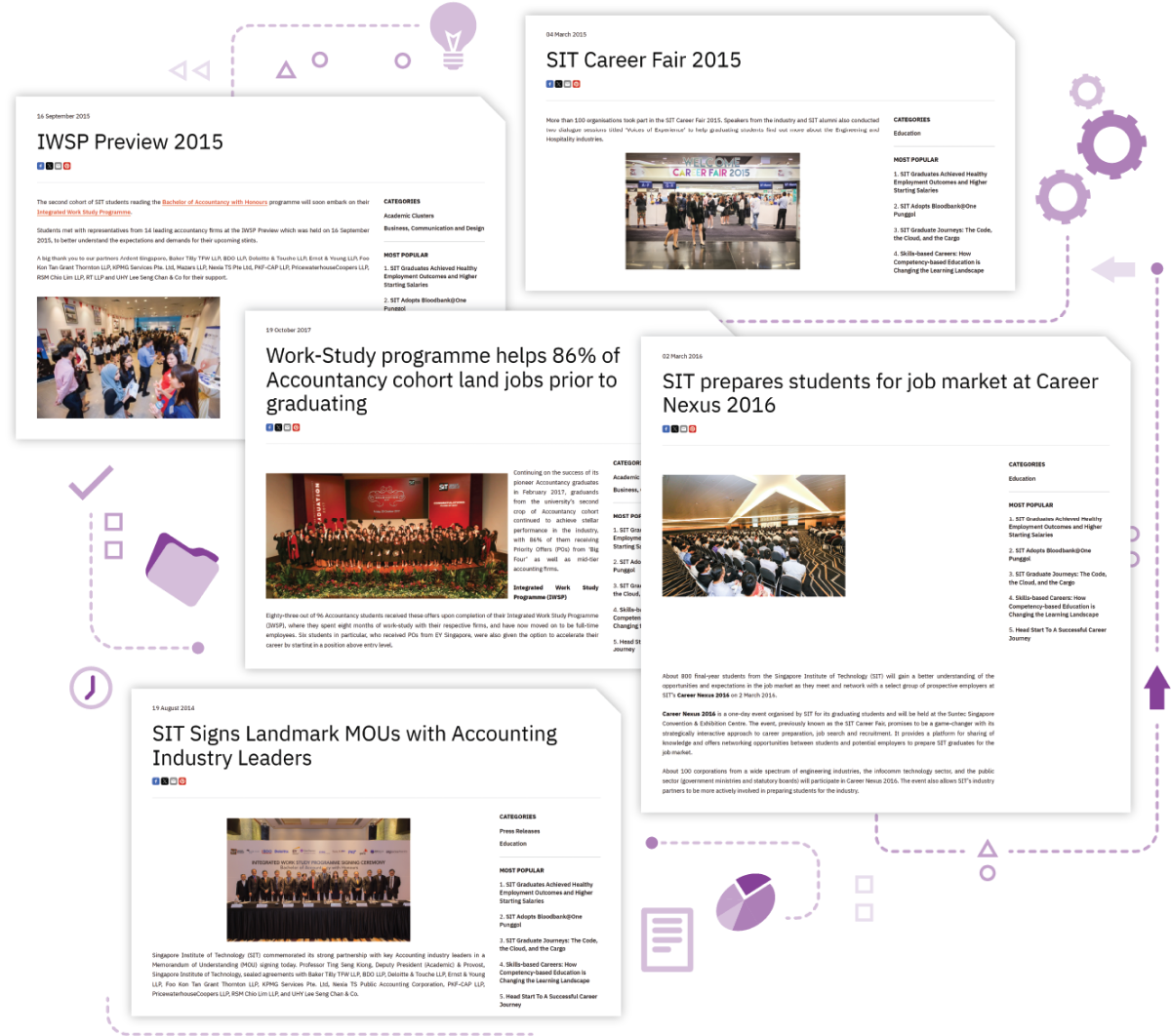
Copyright © 2024 Singapore Institute of Technology. All Rights Reserved.